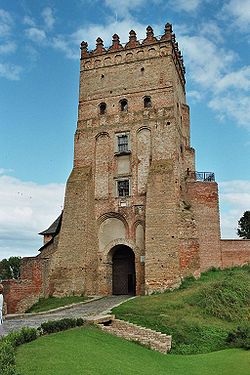Lubart's Castle
This article needs additional citations for verification. (June 2024) |
| Lutsk Castle | |
|---|---|
| Lutsk, Ukraine | |
 Lubart Tower – main gate of the Lutsk Castle | |
| Coordinates | 50°44′20″N 25°19′23″E / 50.73889°N 25.32306°E |
| Type | Castle |
| Site history | |
| Built | 14th century |
| Built by | Liubartas |
| Official name | Замок (Castle) |
| Type | Architecture |
| Reference no. | 030106 |
 | |
Lutsk Castle (Ukrainian: Луцький замок, romanized: Lutskyi zamok;, Polish: Zamek w Łucku), also locally known as Liubart's Castle (Lithuanian: Liubarto pilis, Замок Любарта, Zamok Liubarta) or Upper Castle (Lithuanian: Lucko aukštutinė pilis, Верхній замок, Verkhnii zamok), began its life in the mid-14th century as the fortified seat of Gediminas' son Liubartas (Lubart), the last ruler of united Galicia-Volhynia. It is the most prominent landmark of Lutsk, Ukraine and as such appears on the 200 hryvnia bill. (Another city castle, called Lower Castle, built by the Czartoryski family since the 14th century, is now a ruin).
History
[edit]The Kievan Rus' town of Luchesk had a wooden wall as early as 1075, when Boleslaus the Bold laid siege to it for six months. Yury Dolgoruky failed to take Lutsk after a six-weeks siege in 1149. In 1255, the walls of Lutsk were stormed by Khan Jochi's grandson Kuremsa.[1]
The current castle, towering over the Styr River, was built mostly in the 1340s, although some parts of the earlier walls were used. It repelled sieges by numerous potentates, including Casimir the Great (1349), Jogaila (1431), and Sigismund Kęstutaitis (1436). It was there that the Lutsk Conference of 1429 took place, attended by Emperor Sigismund, Vasily II of Moscow, Jogaila, Vytautas the Great, and the voivode of Wallachia.[2]
During the long reign of Vytautas, Lutsk Castle was further fortified to guard against artillery and gunfire. The principal entrance, now bricked in, was from the west and adjoined a bridge over outer moat. Three main towers, now named "Lubart", "Švitrigaila" (both after Lithuanian princes) and the "Bishop", were built up in the course of the 16th and 17th centuries.
The walls of the castle formerly enclosed St. John's Cathedral, a palace of the grand dukes, and an episcopal palace. Of these buildings, only the Neoclassical palace of the bishops still stands.
On 2 July 1941 1,160 Jews were murdered within the walls of the castle.[3] There is no monument or marker for this tragedy in the castle.
- View of the castle circa 1916
- The castle tower on the reverse of 200 hryvnias banknote
References
[edit]- ^ "Романовская В.Б., Квачадзе О.Б. Политические основы правового статуса человека по средневековому праву городов Руси и Западной Европы XI-XIV вв.: сравнительно-правовой анализ". Genesis: исторические исследования. 3 (3): 255–279. March 2015. doi:10.7256/2409-868x.2015.3.14807. ISSN 2409-868X.
- ^ Pucek, Zdzisław (1992-10-03). "Book review. K. Kowalski, B. Rzebik-Kowalska, 1991: Mammals of Algeria. Wrocław-Warszawa-Kraków, Ossolineum-Zakład Narodowy im. Ossolińskich - Wydawnictwo Polskiej Akademii Nauk. 370 pp". Acta Theriologica. 37: 140. doi:10.4098/at.arch.92-14. ISSN 0001-7051.
- ^ Timothy Snyder: The Life and Death of Western Volhynian Jewry, 1921-1945. In: Ray Brandon, Wendy Lower: The Shoah in Ukraine. Indiana University Press, 2008, ISBN 0-253-35084-0, ISBN 978-0-253-35084-8, S. 92
- Памятники градостроительства и архитектуры Украинской ССР. Киев: Будивельник, 1983—1986. Том 2, с. 48.
External links
[edit]- Walk around Lutsk Castle (video)
 Media related to Lutsk castle at Wikimedia Commons
Media related to Lutsk castle at Wikimedia Commons


 French
French Deutsch
Deutsch


